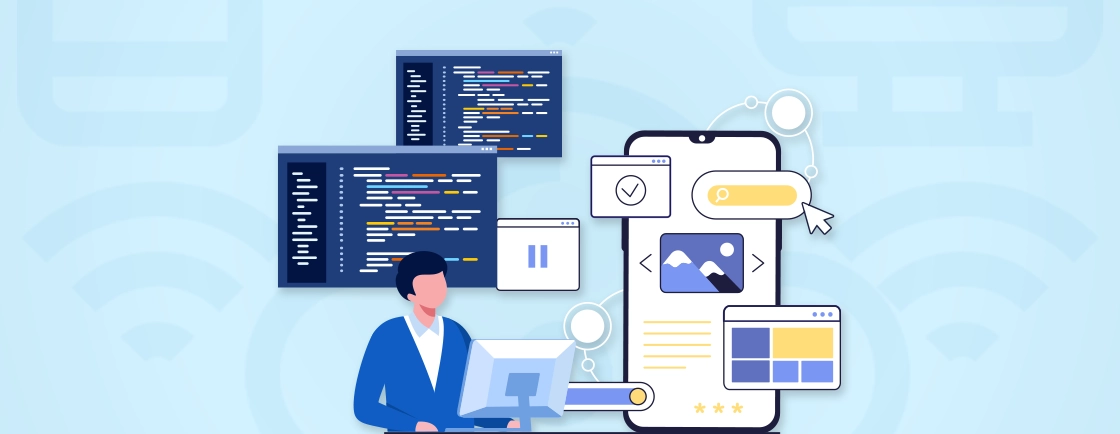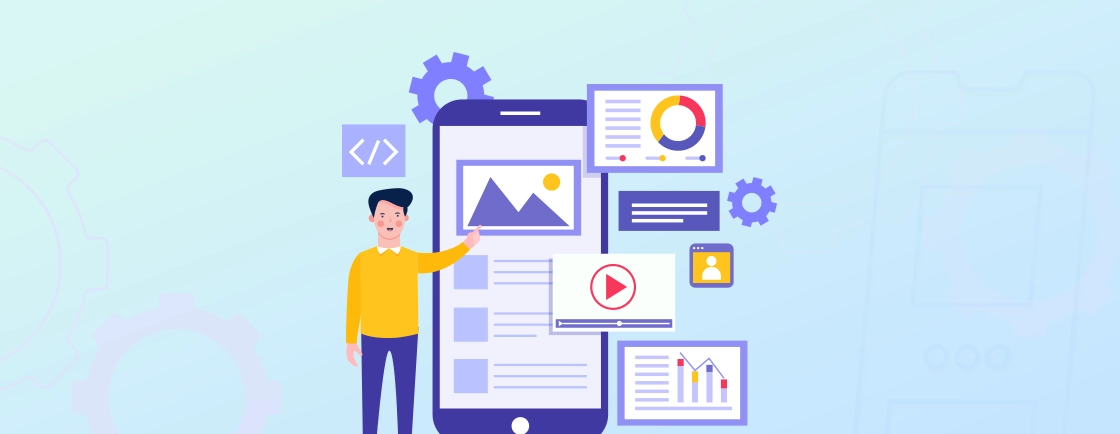Table of Contents
Imagine building a mobile app that works seamlessly on iOS and Android–because choosing between them would exclude millions of users. That means using cross-platform app development.
Frameworks like Flutter, React Native, and Xamarin enable developers to write code once and deploy it everywhere. That ensures consistent performance and user experience. For startups and enterprises alike, this approach offers faster time-to-market, easier scalability, and cost-effective development.
This blog will focus on cross-platform development and how the mobile app experts go about it. By the end, you’ll know if it’s the right strategy for your next app.
What is Cross-Platform App Development?
Cross-platform app development is the process of building mobile applications that run on both the iOS and Android—using a single codebase. Instead of writing separate code for each platform, developers use this approach to create apps that work seamlessly across devices.
This approach reduces development time, cuts costs, and simplifies maintenance while ensuring a consistent user experience. Larger businesses can leverage a cross-platform approach with something like React Native development. They can reach broader audiences without sacrificing performance or functionality.
Native apps may still excel in platform-specific optimizations. But cross-platform solutions have evolved to deliver near-native speed, responsiveness, and design flexibility. That makes them a smart choice for many projects.
Key Features of Cross-Platform App Development
Cross-platform development is the one when businesses want to maximize reach while optimizing resources. Here are its defining features:
Single Codebase for Multiple Platforms
First off, the feature that names this approach. Write once, deploy everywhere. With the cross-platform approach, developers can use one codebase for both iOS and Android platforms. That reduces redundancy and speeds up the development process.
Cost & Time Efficiency
Maintaining a unified codebase slashes development costs and accelerates time-to-market. That makes it ideal for startups and businesses with budget constraints.
Consistent UI/UX Across Platforms
Pre-built widgets and responsive design ensure a uniform look and feel on all devices. It enhances the brand consistency and user experience.
Hot Reload for Faster Iterations
Frameworks like Flutter and React Native support hot reload, enabling real-time updates without full app restarts—boosting developer productivity.
Access to Native Features
Through plugins and APIs, cross-platform apps integrate device-specific functionalities like camera, GPS, and sensors. That is, while maintaining performance close to native apps.
Strong Community & Ecosystem
This mobile app development approach is backed by Google (Flutter), Meta (React Native), and Microsoft (Xamarin). These frameworks offer extensive libraries, tools, and community support for smoother development.
Scalability & Easier Maintenance
A single codebase simplifies updates, bug fixes, and feature rollouts across all platforms, ensuring long-term scalability. Plus, that helps bring down the cost of mobile app development.
Basically, with this development approach, you can offer high-quality features to millions of mobile app users, regardless of their preferred OS.
Pros & Cons of Cross-Platform Mobile App Development
Cross-platform development offers a balanced approach for businesses seeking efficiency and broad reach. But, of course, it also comes with trade-offs. So let’s break down the key advantages and limitations.
Pros of Cross-Platform App Development
- Faster Development & Lower Costs: A single codebase for iOS, Android, and web reduces development time and costs by up to 30-50% compared to native apps.
- Simplified Maintenance: Updates and bug fixes apply universally, eliminating the need for platform-specific adjustments.
- Consistent User Experience: Uniform UI/UX across devices strengthens brand identity and usability.
- Wider Market Reach: Launch simultaneously on multiple platforms, maximizing audience engagement.
- Near-Native Performance: Modern frameworks (Flutter, React Native) deliver 90%+ native-like speed for most apps.
- Hot Reload & Faster Debugging: Instantly preview changes without recompiling, speeding up iterations.
- Strong Backing from Tech Giants: Google (Flutter), Meta (React Native), and Microsoft (Xamarin) ensure continuous improvements and support.
Cons of Cross-Platform App Development
- Limited Access to Native APIs: Some platform-specific features require custom plugins or native coding.
- Performance Bottlenecks for Heavy Apps: Graphics-intensive apps (3D games, AR/VR) may lag behind native solutions.
- Larger App Size: Cross-platform apps often include extra libraries, increasing file size.
- Dependency on Framework Updates: New OS features (e.g., iOS widgets) may take time to integrate into cross-platform tools.
- Potential UI/UX Trade-offs: Achieving pixel-perfect platform-specific designs requires additional effort.
Cross-platform development is ideal for those prioritizing speed and cost-efficiency. These may be MVPs, business apps, or mid-complexity projects. But still, for high-performance apps, native development remains the gold standard.
And if you want the best of this approach while evading the cons, consult with our mobile app development company.
Top Cross-Platform App Development Tools
With this approach, there are several outstanding mobile app development platforms with their own particular details. Let’s jot down the top ones.
Flutter
Developed by Google, Flutter is a game-changer with its fast rendering engine and expressive UI widgets. Write once, run anywhere. Flutter compiles to native ARM code for iOS, Android, web, and even desktop (Windows, macOS, Linux).
It’s hot reload speeds up development, while the rich widget library ensures pixel-perfect designs. Perfect for startups and enterprises alike.
Pros of Flutter
- Fast performance (compiles to native ARM code)
- Single codebase for mobile, web, and desktop
- Hot reload speeds up development
- Rich, customizable widget-based UI
- Strong Google backing and growing community
Cons of Flutter
- Larger app size due to bundled engine
- Limited native library support (may need custom plugins)
- Dart language (less common than JS/TypeScript)
React Native
Backed by Meta (Facebook), React Native lets developers build cross-platform apps using JavaScript and React. It bridges native components for smoother performance and leverages a massive ecosystem of React Native libraries.
It’s ideal for teams familiar with web tech who want near-native performance without rewriting code.
Pros of React Native
- Uses JavaScript/TypeScript (familiar to web devs)
- Large ecosystem (npm libraries, Meta support)
- Near-native performance with native modules
- Live reload for faster debugging
- Strong community & industry adoption
Cons of React Native
- Performance bottlenecks in complex animations
- Dependent on third-party plugins for native features
- Debugging challenges in hybrid environments
Kotlin Multiplatform
JetBrains’ Kotlin Multiplatform (KMP) allows code sharing between platforms while keeping native performance intact. Unlike other frameworks, KMP doesn’t force a UI layer. You can share business logic across iOS, Android, web, and backend, then build native UIs separately.
It’s best for teams prioritizing Kotlin and native flexibility.
Pros of KMP
- Share business logic (not forced into a UI framework)
- True native performance (compiles directly to platforms)
- Interoperable with Java, Swift, and JS
- JetBrains-backed, strong IDE support
Cons of KMP
- Early-stage UI frameworks (Compose Multiplatform still evolving)
- Steeper learning curve for non-Kotlin devs
- Smaller community compared to Flutter/RN
.NET MAUI
Microsoft’s evolution of Xamarin, .NET MAUI, simplifies building iOS, Android, macOS, and Windows apps with C# and XAML. It integrates tightly with Visual Studio and offers native API access. That makes it a strong choice for enterprises already in the Microsoft ecosystem.
Pros of .NET MAUI
- C# & XAML (ideal for Microsoft stack devs)
- Native API access via platform-specific integrations
- Single project structure for multiple platforms
- Visual Studio integration (strong enterprise support)
Cons of .NET MAUI
- Limited community compared to Flutter/React Native
- Slower adoption outside Microsoft ecosystems
- Younger framework (fewer third-party libraries)
Ionic
Built on web technologies (HTML, CSS, JavaScript), Ionic wraps apps in a native shell using Capacitor or Cordova. It’s ideal for PWAs (Progressive Web Apps) and hybrid mobile apps. They prioritize quick development over high-end performance. Great for web-first teams transitioning to mobile.
Pros of Ionic
- Web-friendly (HTML/CSS/JS or Angular/React/Vue)
- Fast prototyping for PWAs and hybrid apps
- Huge plugin library (Cordova/Capacitor)
- Low learning curve for web developers
Cons of Ionic
- Performance lags in graphics-heavy apps
- WebView dependency (not truly native)
- UI feels less native compared to Flutter/RN
Each of these tools has its strengths—pick the “best” one based on your team’s expertise and project needs.
How to Choose the Best Cross-Platform App Development Tool?
Now that you know of the top platforms, the question is–how do you choose the best one? Well, that depends on a range of key factors.
App Performance Requirements
For CPU-heavy apps (AR/VR, gaming), prioritize Flutter or Kotlin Multiplatform. If performance is moderate (business apps), React Native or .NET MAUI work well.
Development Speed & Time-to-Market
Need rapid MVP deployment? Flutter (hot reload) and React Native (reusable components) accelerate development vs. native-like but slower Kotlin Multiplatform.
Team Expertise
JavaScript devs thrive with React Native, while C# teams excel with .NET MAUI. Flutter (Dart) has a steeper learning curve for non-mobile developers.
UI/UX Flexibility
Flutter leads with customizable widgets. React Native offers near-native styling, while Ionic relies on web tech, which may limit fluid animations.
Native Feature Integration
For deep OS-level features (Bluetooth, sensors), Kotlin Multiplatform or React Native (with native modules) outperform Ionic’s web-based approach.
Community & Ecosystem Support
Flutter (Google) and React Native (Meta) dominate in community support. Kotlin Multiplatform and .NET MAUI have smaller but growing ecosystems.
Long-term Maintenance
Flutter and React Native simplify updates with single-codebase fixes. Ionic may require more tweaks for OS compatibility over time.
Try to test a proof-of-concept in your top 2 frameworks before committing. If you need help with the development, get help from our mobile app development agency.
Best Practices for Cross-Platform App Development
There are a few key practices to maximize performance, efficiency, and user experience in cross-platform apps. Follow along.
Choose the Right Framework
Not all frameworks fit every project. Match tools to your needs—Flutter for custom UIs, React Native for JavaScript teams, Kotlin Multiplatform for shared logic. The right choice saves time and headaches.
Optimize UI for Each Platform
Don’t force one design everywhere. Adjust layouts, navigation, and interactions to feel native on iOS and Android. Users expect familiarity—deliver it.
Minimize Dependencies
Too many plugins slow apps and increase bugs. Use only essential libraries and vet third-party code carefully. Less bloat = better performance.
Prioritize Performance
Smooth animations and fast load times matter. Reduce widget complexity, cache assets, and lazy-load data to keep your app feeling snappy.
Streamline State Management
Avoid messy, unmaintainable code. Use proven solutions like Provider (Flutter) or Redux (React Native) to keep app logic clean and predictable.
Write Modular Code
Break features into reusable components. Easier testing, simpler updates, and better teamwork—modular code pays off long-term.
Test Rigorously
Don’t assume “write once, run everywhere” means “works everywhere.” Test on real devices, screen sizes, and OS versions to catch platform quirks.
Monitor and Optimize
Launch is just the start. Track crash reports, performance metrics, and user feedback to refine your app over time.
Again, start with a Proof of Concept (PoC) to validate technical feasibility before full-scale development.
Let’s Conclude
Cross-platform development has revolutionized mobile app creation by offering speed, cost-efficiency, and broader reach. That too without sacrificing quality. With this approach, there are some tools available, like Flutter, React Native, Kotlin Multiplatform, .NET MAUI, and Ionic.
You can choose cross-platform for faster development, unified maintenance, and budget-friendly scaling. But opt for native if your app demands heavy graphics or deep OS integrations.
So, want to get the best of this approach for your mobile apps? Then hire mobile app developer today!
FAQs on Cross-Platform App Development
How does cross-platform differ from native development?
Native apps are built separately for each platform (Swift/Kotlin) for maximum performance. But Cross-platform apps use one codebase but may have slight trade-offs in performance or OS-specific features.
Are cross-platform apps slower than native apps?
Modern tools like Flutter and React Native deliver near-native performance for most apps. However, graphics-heavy apps (3D games, AR/VR) may still perform better in native code.
Can cross-platform apps use device hardware (camera, GPS)?
Yes! Most frameworks support native plugins (e.g., React Native’s Expo, Flutter’s plugins) to access device features like cameras, sensors, and Bluetooth.
How much does cross-platform app development cost?
Typically 30–50% cheaper than native since one team maintains a single codebase. Costs vary based on app complexity and framework.
Can I convert a cross-platform app to native later?
Yes, but it requires significant rework. Plan ahead if you anticipate needing full native performance.
Elevate Your App Development Journey
Explore comprehensive guides, industry trends, and expert advice to build innovative mobile applications.





